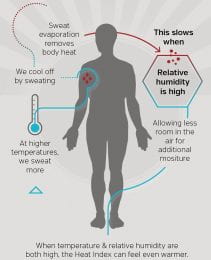Heat is one the leading causes of weather-related deaths and injuries in the United States. Excessive heat causes hundreds of deaths every year. Heat can affect people in a variety of settings and while dangerous heat is associated with the summer season, it can occur in the spring and fall as well.
The risk
When exposed to high temperatures your body sweats, which evaporates to cool your body. Hot and humid weather challenges your body’s ability to cool itself because your body sweats a great deal to try to maintain your body temperature. Over time this increased sweating leads to dehydration and your body temperature becomes elevated. Increased levels of humidity make this worse as the high water content of the air hampers the evaporation of sweat on your skin. This can result in heat exhaustion or heat stroke. Those most at risk for heat illness include infants, children, the elderly, overweight people and those who are ill or have certain medical conditions such as high blood pressure.
Heat exhaustion
Heat exhaustion is a mild form of heat illness that may develop after days of exposure to high temperatures and inadequate fluid intake. If not treated, heat exhaustion may become heat stroke. A person suffering from heat exhaustion may have cool moist skin. Their pulse rate will be fast and weak and their breathing will be fast and shallow. Additional warning signs of heat exhaustion include:
- Heavy sweating
- Paleness
- Muscle cramps
- Tiredness
- Weakness
- Dizziness
- Headache
- Nausea or vomiting
- Fainting
Heat exhaustion first aid
- Drink cool beverages without alcohol or caffeine.
- Move to an air-conditioned environment.
- Take a cool shower, bath or apply cold compresses.
- Rest
Heat stroke
Heat stroke is the most serious of heat-related illnesses. It occurs when the body is unable to cool itself because the ability to sweat fails. A victim’s body temperature will rapidly rise within a few minutes. Heat stroke can cause death or permanent injury if it is not treated quickly. Warning signs of heat stroke vary but can include:
- An extremely high body temperature — above 103 degrees Fahrenheit.
- Red, hot and dry skin without sweating.
- Rapid, strong pulse.
- Throbbing headache.
- Dizziness.
- Nausea.
- Confusion.
- Unconsciousness.
Heat stroke first aid
- Call 911 immediately. Untreated heat stroke may result in death or disability.
- Move the victim to a shady and/or air-conditioned area.
- Cool the victim rapidly using whatever means available such as a cool shower or bath, garden hose, or sponging with cool water.
Prevention
Like many hazards there are steps you can take to avoid becoming a victim of heat illnesses.
- Drink lots of water and avoid alcohol and caffeine.
- Limit strenuous outdoor activities.
- Wear light colored, light weight clothing.
- Use sunscreen.
- Take breaks in the shade as often as possible.
- If working in the heat, increase workloads gradually. Allow new employees and workers who have been off for more than a week more frequent breaks.
- Change your schedule so outdoor work is performed early or very late in the day.
- NEVER leave kids or pets in vehicles.
- Check on the elderly, sick and those without air conditioning.
- Be aware of the symptoms of heat illness and take action if you see someone at risk.
Sources
